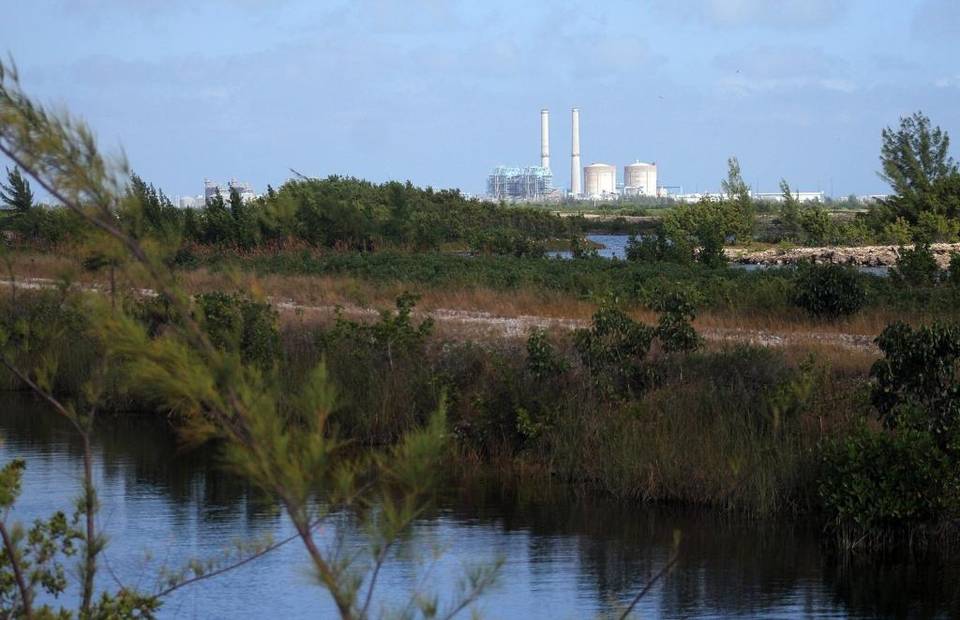
A view of the Turkey Point Nuclear Power Plant, with cooling canals in the foreground. Allison Diaz For the Miami Herald
Much has been written about radioactive tritium near nuclear facilities across the country. As a university researcher with expertise in radiation protection and safety, I often see information and opinions that use language to create a sense of fear in the public. My hope here is to offer a response that is more objective from a safety and risk perspective.
Tritium, a radioactive form of hydrogen, is created at measureable levels every second of every day from the bombardment of cosmic radiation with our upper atmosphere. This is normal and contributes a small fraction to the natural background radiation dose on Planet Earth. The amount of radionuclides such as tritium that exists in our “background” varies somewhat depending upon where we live.
A recent study measured elevated tritium concentrations in Biscayne Bay with one sample having 215 times that of the background level. Although it appears the increased tritium can be attributed to cooling canals at the Turkey Point nuclear plant, the elevated tritium samples are from only four isolated, artificial, deep trenches and not representative of water in the bay, much less water extracted for drinking.
The one sample that measured 215 times the local tritium background level is 22 percent lower than the drinking-water standard for tritium as set by the U.S. Environmental Protection Agency, which is 0.00000002 Curies per liter (or 6.2 parts per trillion tritium to hydrogen). For perspective, one part per trillion is equivalent to about one drop of tritium inside an Olympic-sized swimming pool that contains 288,000 gallons.
This drinking-water standard for tritium was determined from an acceptable annual dose of four millirem that one would receive by drinking water at this maximum allowable contamination level every day for a year.
How does four millirem compare to our daily dose from other sources? We all receive nuclear radiation continuously from many sources, such as radioactive radon gas, radioactivity found in soils and construction material, smoke detectors in our homes and all food we consume. The average annual radiation dose in the United States is 620 millirem. About half of this is from natural sources, and the other half is from medical sources.
In 1987, the average dose in the United States was 360 millirem, with 15 percent from medical procedures. Therefore there was an increase in average background radiation dose of 260 millirem from 1987 to 2006. The number of nuclear medicine procedures in the country since 2006 has increased more than 20 times; hence the average radiation dose today is likely significantly higher than the 620 millirem determined in 2006. This information is offered in comparison to the four millirem one would receive if one were to drink water for a year at the maximum allowable tritium level allowed.
All food is radioactive. The bananas, nuts, and carrots I eat each year as part of a healthy diet contribute to more than 15 millirem of my annual dose. So, are the elevated levels seen from those isolated artificial, deep trenches adjacent to Biscayne Bay a safety concern? No. Its relative risk is well below that of actions I take daily.
Tritium and radiation are around us every day. Nuclear radiation is monitored closely. The release of radioactivity from coal piles and from medical facilities greatly exceeds that from nuclear power facilities, and these industries are all regulated differently.
What does this all mean? The four-millirem annual dose from consuming water for a year at the maximum allowable tritium levels would contribute less than 1 percent to the average annual radiation dose to the public. The public drinking water supplied to neighborhoods around nuclear facilities is typically at less than 10 percent of the maximum allowable tritium level.
The maximum allowable concentrations for radionuclides in the drinking water in the United States is conservative and safe. The local drinking water in the Biscayne Bay, and Southeast Florida’s drinking water, is well below these maximum allowable concentrations.
Facts matter. Science matters. Let’s keep this issue in perspective to the level of risk. Let’s not get lost in facts, figures or opinions that are not presented in a way to allow the public to understand the real risks.
DAVID ROELANT IS THE INTERIM RADIATION SAFETY OFFICER AND A RESEARCHER AT FLORIDA INTERNATIONAL UNIVERSITY.